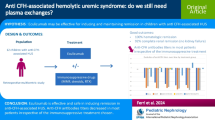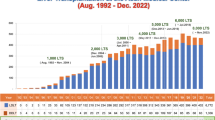Abstract
Background
Laparoscopic splenectomy (LS) offers better short-term results than open surgery for the treatment of immune thrombocytopenic purpura (ITP), but long-term follow-up is required to ensure its efficacy. The remission rate after splenectomy ranges from 49 to 86% and the factors that predict a successful response to surgical management have not been clearly defined. The goal of this study was to determine the preoperative factors that predict a successful outcome following LS.
Methods
From February 1993 to December 2003, LS was consecutively performed in a series of 119 nonselected patients diagnosed with ITP (34 men and 85 women; mean age, 41 years), and clinical results were prospectively recorded. Postoperative follow-up was based on clinical records, follow-up data provided by the referring hematologist, and a phone interview with the patient and/or relative. Univariate and multivariate analyses were performed for clinical preoperative variables to identify predictive factors of success following LS.
Results
Over a mean period of 33 months, 103 patients (84%) were available for follow-up with a remission rate of 89% (92 patients, 77 with complete remission with platelet count >150,000). Eleven patients did not respond to surgery (platelet count <50,000). Mortality during follow-up was 2.5% (two cases not related to hematological pathology and one case without response to splenectomy). Preoperative clinical variables evaluated to identify predictive factors of response to surgery were sex, age, treatment (corticoids alone or associated with Ig or chemotherapy), other immune pathology, duration of disease, and preoperative platelet count. In a subgroup of 52 patients, we also evaluated the type of autoantibodies and corticoid doses required to maintain a platelet count >50,000. Multivariate analysis showed that none of the variables evaluated could be considered as predictive factors of response to LS due to the high standard error.
Conclusion
Long-term clinical results show that LS is a safe and effective therapy for ITP. However, a higher number of nonresponders is needed to determine which variables predict response to LS for ITP.
Similar content being viewed by others
References
Aksnes J, Abdelnoor M, Mathisen O (1995) Risk factors associated with mortality and morbidity after elective splenectomy. Eur J Surg 161: 253–258
Akwari OE, Itan KMF, Coleman RE, Rosse WF (1987) Splenectomy for primary and recurrent immune thrombocytopenic purpura (ITP). Ann Surg 206: 529–541
Bourgeois E, Caulier MT, Delarozee C, Brouillard M, Bauters F, Fenaux P (2003) Long-term follow-up of chronic autoimmune thrombocytopenic purpura refractory to splenectomy: a prospective analysis. Br J Haematol 120: 1079–1088
Cohen YC, Djulbegovic B, Shamai-Lubovitz O, Mozes B (2000) The bleeding risk and natural history of idiopathic thrombocytopenic purpura in patients with persistent low platelet counts. Arch Int Med 160: 1630–1638
Cola B, Tonielli E, Sacco S (1986) Surgical treatment of chronic idiopathic thrombocytopenic purpura: results in 107 cases. Int Surg 71: 195–198
Delaitre B, Maignien B (1991) Splenectomy by the coelioscopic approach: report of a case. Presse Med 20: 2263
DiFino SM, Lachant NA, Kirshner JJ (1980) Adult idiopathic thrombocytopenic purpura. Clinical findings and response to therapy. Am J Med 69: 430–442
Duperier T, Brody F, Felsher J, Walsh M, Rosen M, Ponsky J (2004) Predictive factors for successful laparoscopic splenectomy in patients with immune thrombocytopenic purpura. Arch Surg 139: 61–66
Fabris F, Tassan T, Ramon R, Carraro G, Randi ML, Luzzatto G, Moschino P, Girolami A (2001) Age as the major predictive factor of long-term response to splenectomy in immune thrombocytopenic purpura. Br J Haematol 112: 637–640
Fabris F, Zanatta N, Casonato A, Randi ML, Luzzatto G, Girolami A (1989) Response to splenectomy in idiopathic thrombocytopenic purpura: prognostic value of the clinical and laboratory evaluation. Acta Haematol 81: 28–33
Fenaux P, Caulier MT, Hirschauer MC, Beuscart R, Goudemand J, Bauters F (1989) Reevaluation of the prognostic factors for splenectomy in chronic idiopathic thrombocytopenic purpura: a report of 181 cases. Eur J Haematol 42: 259–264
George JN, Woolf SH, Raskob GE (1996) Idiopathic thrombocytopenic purpura: a practice guideline developed by explicit methods for the American Society of Haematology. Blood 88: 3–40
Gugliotta L, Isacchi G, Guarini A, et al (1981) Chronic idiopathic thrombocytopenic purpura: site of platelet sequestration and results of splenectomy. Scand J Haematol 26: 407–412
Harold KL, Schinklert RT, Mann DK, Reeder CB, Noel P, Fitch TR, Braich TA, Camoriano JK (1999) Long-term results of laparoscopic splenectomy for immune thrombocytopenic purpura. Mayo Clinic Proc 74: 37–39
Julia A, Araguas C, Rossello J, Bueno J, Doemnech P, Olona M, Guardia R, Petit J, Flores A (1990) Lack of useful clinical predictors of response to splenectomy in patients with chronic idiopathic thrombocytopenic purpura. Br J Hematol 76: 250–255
Katkhouda N, Grant SW, Mayor E, Friedlander MH, Lord RV, Achanta K, Essani R, Mason R (2001) Predictors of response after laparoscopic splenectomy for immune thrombocytopenic purpura. Surg Endosc 15: 484–488
Kathkouda N, Hurtwitz MB, Rivera RT, Chandra M, Waldrep DJ, Gugenheim J, Mouiel J (1998) Laparoscopic splenectomy: outcome and efficacy in 103 consecutive cases. Ann Surg 228: 568–578
Kumar S, Diehn FE, Gertz MA, Tefferi A (2002) Splenectomy for immune thrombocytopenic purpura: long-term results and treatment of postsplenectomy relapses. Ann Hematol 81: 312–319
Lord RNV, Coleman MF, Milliken ST (1998) Splenectomy for HIV-related immune thrombocytopenia. Arch Surg 133: 205–210
Mintz SJ, Petersen SR, Cheson B, Cordell LJ, Richards RC (1981) Splenectomy for immune thrombocytopenic purpura. Arch Surg 116: 645–650
Pizzuto J, Ambriz R (1984) Therapeutic experience on 934 adults with idiopathic thrombocytopenic purpura: multicentric trial of the cooperative Latin American group on hemostasis and thrombosis. Blood 64: 1179–1183
Portielje JE, Westendorp RG, Kluin-Nelemans HAC, Brand A (2001) Morbidity and mortality in adults with idiopathic thrombocytopenic purpura. Blood 97: 2549–2554
Radaelly F, Faccini P, Goldaniga M (2000) Factors predicting response to splenectomy in adult patients with idiopathic thrombocytopenic purpura. Haematologica 85: 1040–1044
Rege RV, Jowhl RJ (1999) A learning curve for laparoscopic splenectomy at an academic institution. J Surg Res 81: 27–32
Rosen M, Brody F, Walsh RM, Tarnoff M, Malm J, Ponsky J (2002) Outcome of laparoscopic splenectomy based on hematologic indication. Surg Endosc 16: 272–279
Rudowski WJ (1985) Accessory spleens: clinical significance with particular reference to the recurrence of idiopathic thrombocytopenic purpura. World J Surg 9: 422–430
Ruivard M, Caulier MT, Vantelon JM (1999) The response to high-dose intravenous immunoglobulin or steroids is not predictive of outcome after splenectomy in adults with autoimmune thrombocytopenic purpura. Br J Haematol 105: 1130–1132
Schiavotto C, Rodeghiero F (1993) Twenty years experience with treatment of idiopathic thrombocytopenic purpura in a single department: results in 490 cases. Haematologica 78: 22–28
Stanton CJ (1999) Laparoscopic splenectomy for idiopathic thrombocytopenic purpura (ITP): a five-year experience. Surg Endosc 13: 1083–1086
Targarona EM, Cerdán G, Gracia E, Rodríguez M, Trias M (2001) Results of laparoscopic splenectomy for treatment of malignant conditions. HPB Surg 3: 251–255
Targarona EM, Espert JJ, Balagué C, Sugrañes G, Ayuso C, Trías M (1998) Residual splenic function after laparoscopic splenectomy. A clinical concern. Arch Surg 133: 56–60
Trías M, Targarona EM, Espert JJ, Balagué C (1998) Laparoscopic surgery for splenic disorders. Lessons learned from a series of 64 cases. Surg Endosc 12: 66–72
Trias M, Targarona EM, Espert JJ, Cerdan G, Bombuy E, Vidal O, Artigas V (2000) Impact of hematological diagnosis on early and late outcome after laparoscopic splenectomy. An analysis of 111 cases. Surg Endosc 14: 556–560
Tsereteli Z, Smith CD, Branum GD, Galloway JR, Amerson RJ, Chakaraborty H, Hunter JG (2001) Are the favorable outcomes of splenectomy predictable in patients with idiopathic thrombocytopenic purpura (ITP)? Surg Endosc 15: 1386–1389
Watson D, Coventry B, Chin T, Gill G, Malycha P (1997) Laparoscopic versus open splenectomy for immune thrombocytopenic purpura. Surgery 11: 18–22
Winde G, Schmid KW, Lugering N, Fischer R, Brandt B, Bems T, Bunte H (1996) Results and prognostic factors of splenectomy in idiopathic thrombocytopenic purpura. J Am Coll Surg 183: 565–574
Yee LF, Carvajal SH, De Lorimer AA, Malvihill SJ (1995) Laparoscopic splenectomy. Arch Surg 130: 874–879
Author information
Authors and Affiliations
Corresponding author
Rights and permissions
About this article
Cite this article
Balagué, C., Vela, S., Targarona, E.M. et al. Predictive factors for successful laparoscopic splenectomy in immune thrombocytopenic purpura. Surg Endosc 20, 1208–1213 (2006). https://doi.org/10.1007/s00464-005-0445-6
Received:
Accepted:
Published:
Issue Date:
DOI: https://doi.org/10.1007/s00464-005-0445-6




